e-AWB. International Air Transport Association

Electronic Air Waybill (e-AWB) IATA: International Air Transport
- Introduction to the International Air Transport Association (IATA)
- History of the IATA
- IATA Air Cargo Programs
- Electronic Air Waybill (e-AWB). Electronic Air Waybill Resolution
- e-Freight program. Interactive Cargo
- Unit Load Devices (ULD)
- IATA Dangerous Goods Regulations (DGR)
- The Single African Air Transport Market (SAATM)

The Subject “International Air Transport Association (IATA). e-AWB.” belongs to the following Online Programs taught by EENI Global Business School:
Courses: Air transport, Multimodal transport, Transport in Africa.
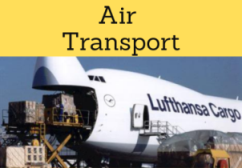
Diplomas: Foreign Trade, International Transport.
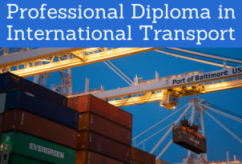
Masters: International Transport, Transport in Africa, International Business, Foreign Trade.
Doctorate: Global Logistics, World Trade.
Languages: 
 Asociación de Transporte Aéreo Internacional (IATA)
Asociación de Transporte Aéreo Internacional (IATA)
 Association du transport aérien international (IATA)
Association du transport aérien international (IATA)  Associação Internacional de Transporte Aéreo (IATA).
Associação Internacional de Transporte Aéreo (IATA).
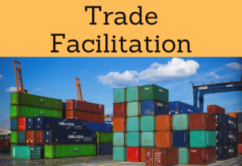
Sample - International Air Transport Association (IATA). e-AWB.
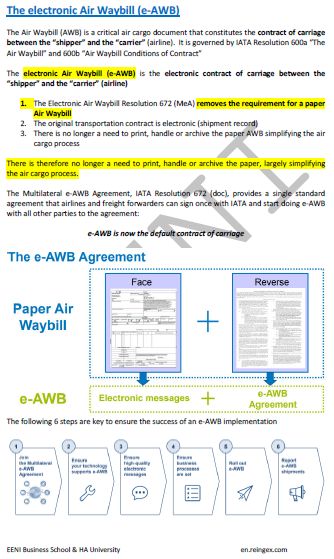
International Air Transport Association (IATA). e-AWB.
The International Air Transport Association (IATA) is the largest global association related to the air cargo and passenger transport. It is made up of 290 airlines from 120 countries, representing 82% of the total air traffic.
The Air Waybill (AWB) is an air cargo document that constitutes the contract of carriage between the sender and the carrier (airline).
- The resolution on the IATA Air Waybill (e-AWB) eliminates the requirement for an AWB on paper
- e-AWB is now the default transportation contract for the international air cargo transport
- In September 2018, the air cargo industry processed more than 2.3 million air waybills (AWB)
- 76% of the AWBs are generated in Europe, Asia-Pacific and North Asia
- The global penetration of the e-AWB is currently estimated at 56%
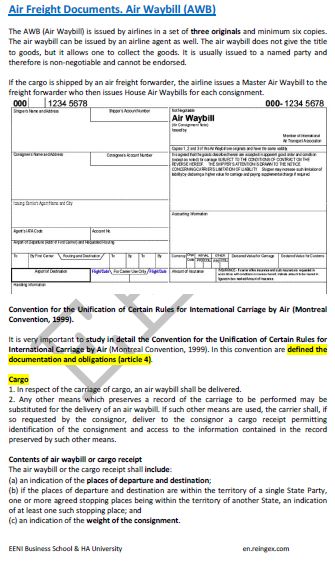
The Unit Load Devices, mainly containers, allow a fast and economic handling for the Air Transport cargo. The International Air Transport Association (IATA) developed the technical specifications for this type of unit load devices.
- The International Air Transport Association (IATA) also developed the Dangerous Goods Regulations for Safe Transportation
- IATA has developed several programs to reduce the costs in the Air Transport value chain
The Air Cargo Programs of the International Air Transport Association (IATA) are:
- Dangerous Goods (HAZMAT)
- Live animals
- StB Cargo
- Digital Cargo (e-Cargo)
- Cargo security
- Cargo operations
- Cargo iQ
- Pharmaceutical and health products
- Unit Load Devices
- Perishables
- Freight agency program
- Customs and trade facilitation
- Cargo Sustainability
- Air mail
- Future Air Cargo Executive (FACE)
The Airlines transport more than 52 million metric tons of products per year, representing more than 35% of world trade in value, but less than 1% of world trade in volume.
The International Air Transport Association (IATA) was created in Havana (Cuba) in 1945. The IATA is the successor to the International Air Traffic Association founded in The Hague in 1919.
In 1944, the IATA introduced the Chicago Convention.
The member countries of the Single African Air Transport Market (SAATM) are Benin, Cape Verde, Republic of the Congo, Ivory Coast, Egypt, Ethiopia, Kenya, Nigeria, Rwanda, South Africa and Zimbabwe.
The BIC Code (International Identification Codes of Container Owners) is accepted by the International Air Transport Association (IATA):
Trade Facilitation - Trade Facilitation Agreement - Kyoto Convention - Convention Harmonization of Frontier Controls of Goods.
(c) EENI Global Business School (1995-2024)
We do not use cookies
Top of this page



